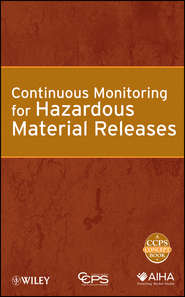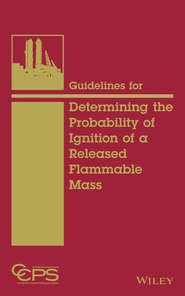Книги автора CCPS (Center for Chemical Proc
CCPS (Center for Chemical Proc
современная русская литератураChemical process quantitative risk analysis (CPQRA) as applied to the CPI was first fully described in the first edition of this CCPS Guidel…
Chemical process quantitative risk analysis (CPQRA) as applied to the CPI was first fully described in the first edition of this CCPS Guidel…
CCPS (Center for Chemical Proc
остросюжетные любовные романы, творчествоWhether occurring accidentally or through acts of terrorism, catastrophic chemical releases must be identified early in order to mitigate th…
Whether occurring accidentally or through acts of terrorism, catastrophic chemical releases must be identified early in order to mitigate th…
CCPS (Center for Chemical Proc
триллеры, зарубежные детективы, яхты, Австралия, месть, психологические триллеры, мировой бестселлер, семейные тайныThis guide provides an overview of methods for estimating the characteristics of vapor cloud explosions, flash fires, and boiling-liquid-exp…
This guide provides an overview of methods for estimating the characteristics of vapor cloud explosions, flash fires, and boiling-liquid-exp…
CCPS (Center for Chemical Proc
сказки, детская фантастика, русское фэнтези, славянское фэнтези, страшные сказки, Хэллоуин, этническое фэнтезиWith new and growing interest in dealing with the hazards of reactive chemicals, this book offers guidelines that can significantly reduce t…
With new and growing interest in dealing with the hazards of reactive chemicals, this book offers guidelines that can significantly reduce t…
CCPS (Center for Chemical Proc
кинематограф / театр, развитие речи, художественная речь, сценическое искусство, учебники и пособия для ссузов, речеведениеAn essential guide that offers an understanding of and the practices needed to assess and strengthen process safety culture Essential Practi…
An essential guide that offers an understanding of and the practices needed to assess and strengthen process safety culture Essential Practi…
CCPS (Center for Chemical Proc
иронические детективы, тайны, авантюрные детективы, частное расследование, ЛитРес: чтец, легкое чтениеThis book describes how to conduct a Combustible Dust Hazard Analysis (CDHA) for processes handling combustible solids. The book explains ho…
This book describes how to conduct a Combustible Dust Hazard Analysis (CDHA) for processes handling combustible solids. The book explains ho…
CCPS (Center for Chemical Proc
основы производстваComplemented by an estimating tool spreadsheet based on a fixed set of chemicals to assist in risk estimations, Probability of Ignition of a…
Complemented by an estimating tool spreadsheet based on a fixed set of chemicals to assist in risk estimations, Probability of Ignition of a…
CCPS (Center for Chemical Proc
книги по экономикеThis book combines the synergies between performance improvement systems to help ensure safe and reliable operations, streamline procedures …
This book combines the synergies between performance improvement systems to help ensure safe and reliable operations, streamline procedures …
CCPS (Center for Chemical Proc
развлечения, журнальные изданияThere is much industry guidance on implementing engineering projects and a similar amount of guidance on Process Safety Management (PSM). Ho…
There is much industry guidance on implementing engineering projects and a similar amount of guidance on Process Safety Management (PSM). Ho…
CCPS (Center for Chemical Proc
немецкий языкFirst-line managers have to maintain the integrity of facilities, control manufacturing processes, and handle unusual or emergency situation…
First-line managers have to maintain the integrity of facilities, control manufacturing processes, and handle unusual or emergency situation…
CCPS (Center for Chemical Proc
зарубежная компьютерная литература, интернет, программирование, веб-технологии, создание сайтов, защита информации, веб-программирование, безопасность в Интернете, разработка приложений, информационная безопасностьProviding in-depth guidance on how to design and rate emergency pressure relief systems, Guidelines for Pressure Relief and Effluent Handlin…
Providing in-depth guidance on how to design and rate emergency pressure relief systems, Guidelines for Pressure Relief and Effluent Handlin…
CCPS (Center for Chemical Proc
ЕГЭ по литературе, учебные справочники, единый государственный экзамен (ЕГЭ), школьное образование, экзамен по литературе, задания по литературе, подготовка к экзаменамThis Guideline presents the framework of process safety knowledge and expertise versus the desired competency level in a «super-matrix» form…
This Guideline presents the framework of process safety knowledge and expertise versus the desired competency level in a «super-matrix» form…
CCPS (Center for Chemical Proc
учебники и пособия для вузовPowders and bulk solids, handled widely in the chemical, pharmaceutical, agriculture, smelting, and other industries present unique fire, ex…
Powders and bulk solids, handled widely in the chemical, pharmaceutical, agriculture, smelting, and other industries present unique fire, ex…
CCPS (Center for Chemical Proc
учебная литература, прочая образовательная литература, история РоссииThe second edition of this essential reference updates and combines two earlier titles to capture the many technological advances for predic…
The second edition of this essential reference updates and combines two earlier titles to capture the many technological advances for predic…
CCPS (Center for Chemical Proc
бухучет / налогообложение / аудит, учебники и пособия для вузовThe EPA investigation of a 1994 chemical plant tragedy concluded that «the explosion resulted from a lack of written safe operating procedur…
The EPA investigation of a 1994 chemical plant tragedy concluded that «the explosion resulted from a lack of written safe operating procedur…
CCPS (Center for Chemical Proc
Current industry, government and public emphasis on containment of hazardous materials makes it essential for each plant to reduce and contr…
Current industry, government and public emphasis on containment of hazardous materials makes it essential for each plant to reduce and contr…
CCPS (Center for Chemical Proc
любовное фэнтези, магические миры, романтическое фэнтези, отбор невестProcess safety metrics is a topic of frequent conversation within chemical industry associations. Guidelines for Process Safety Metrics prov…
Process safety metrics is a topic of frequent conversation within chemical industry associations. Guidelines for Process Safety Metrics prov…
CCPS (Center for Chemical Proc
стихи и поэзияWritten by a committee of safety professionals, this book creates a foundation document for the development and application of risk toleranc…
Written by a committee of safety professionals, this book creates a foundation document for the development and application of risk toleranc…
CCPS (Center for Chemical Proc
современная русская литератураWhile there is no «perfect» solution or absolute zero risk, engineering design can significantly reduce risk potential in the CPI. In Guidel…
While there is no «perfect» solution or absolute zero risk, engineering design can significantly reduce risk potential in the CPI. In Guidel…
CCPS (Center for Chemical Proc
ужасы, русское фэнтези, мифы / легенды / эпос, славянская мифология, славянское фэнтези, этническое фэнтези, мифологическое фэнтезиThis book provides a valuable reference tool for technical and management personnel who lead or are a part of incident investigation teams. …
This book provides a valuable reference tool for technical and management personnel who lead or are a part of incident investigation teams. …

































